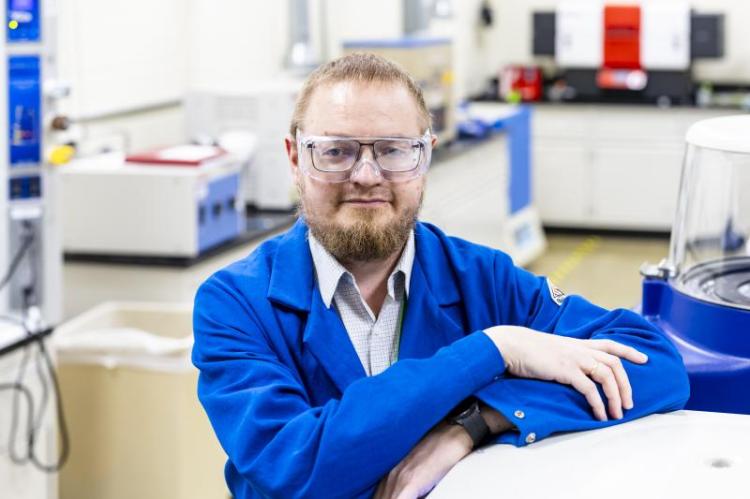--
Researchers at ORNL are contributing leadership to a new national consortium aimed at scaling up manufacturing of hydrogen technology. Credit: ORNL, U.S. Dept. of Energy
The Department of Energy's Oak Ridge National Laboratory is providing national leadership in a new collaboration among five national laboratories to accelerate U.S. production of clean hydrogen fuel cells and electrolyzers.
Hydrogen fuel cells provide power to electric vehicles and buildings using an electrochemical reaction that converts hydrogen and oxygen into heat, water and electricity. The Roll-to-Roll, or R2R, Consortium aims to scale up, speed up and reduce the cost of producing key components of fuel cells and electrolyzers where water molecules are split to make hydrogen. Improving manufacturing technologies for green hydrogen will help bring the U.S. closer to achieving its carbon reduction goals to slow climate change.
"The consortium's goal is to accelerate commercialization of these fuel cells and electrolyzers through comprehensive understanding of full-scale materials development, electrode fabrication, advanced computing and quality control," said ORNL scientist Alexey Serov.

As a member of DOE's new Roll-to-Roll Consortium, ORNL is working on commercial scale-up of hydrogen fuel cell and electrolyzer components, such as this catalyst film being produced in ORNL's Battery Manufacturing Laboratory. Credit: Alexey Serov/ORNL, US Dept. of Energy
Serov and his colleague Yuepeng Zhang at Argonne National Laboratory are deputy directors of the R2R Consortium, which is led by Scott Mauger at the National Renewable Energy Laboratory, or NREL. Lawrence Berkeley National Laboratory and Sandia National Laboratories are also partners in the consortium, funded by DOE's Office of Energy Efficiency and Renewable Energy Hydrogen and Fuel Cell Technologies Office, or HFTO, through two provisions in the Bipartisan Infrastructure Law: the Clean Hydrogen Electrolysis Program and the Clean Hydrogen Manufacturing and Recycling Program.
Both electrolyzers and fuel cells have parts similar to a battery: Positively and negatively charged electrodes on opposite poles draw ions through an electrolyte. A catalyst at the surface of the electrodes accelerates an electrochemical reaction, which separates or combines hydrogen and oxygen.To manufacture these devices, an active material is coated onto an underlayer being continuously moved by rollers - in other words, a "roll-to-roll" production process.
ORNL's role in the R2R Consortium will focus on scaling up fuel cell and electrolyzer catalysts, which speed up reactions. Scientists at ORNL and Argonne National Laboratory are already collaborating on crucial aspects of this research. The ORNL team will be working with researchers at NREL on scalable methods of manufacturing electrodes for fuel cells and electrolyzers. Additionally, ORNL will lead a consortium effort on using computer modelling to understand fluid, heat and other flows in advanced chemical reactors for scaling up production of platinum and iridium electrocatalysts.

ORNL's Alexey Serov will serve as a deputy director of the R2R Consortium. Credit: Carlos Jones/ORNL, US Department of Energy
"ORNL's team brings its unique expertise to co-lead an effort on materials scale-up though state-of-the art roll-to-roll coating capabilities, world-class imaging and microscopy, and advanced modelling and manufacturing processes redesign," Serov said.
The goal is to rapidly develop and demonstrate new, cleaner and more affordable manufacturing processes to boost industry adoption of clean hydrogen technologies. Roll-to-roll manufacturing can reduce costs by increasing process efficiency and reducing material waste, but research will address challenges related to synthesizing materials, mixing, coating, drying and quality-control processes and equipment.
The consortium also plans to collaborate with industry on cooperative research and development agreements, with more details to be announced soon. An industrial advisory board will guide the consortium's research objectives and increase engagement among manufacturers, materials suppliers and the hydrogen industry.
Home to the country's largest open-access facility for battery manufacturing research and development, ORNL offers crucial opportunities to scale up laboratory discoveries using roll-to-roll coating, electron microscopes and other specialized tools. ORNL scientists Flavio Dal Forno Chuahy and David Cullen will join Serov to support consortium research.
R2R activities will also complement the work of other HFTO consortia, Hydrogen from Next-generation Electrolyzers of Water, orH2NEW, and Million Mile Fuel Cell Truck, or M2FCT. The R2R Consortium will develop processes and pathways to scale up materials and components developed by H2NEW and M2FCT and will work closely with both consortia to ensure relevant metrics, methods and protocols are used.
Together, these efforts will help advance DOE's H2@Scale vision and Hydrogen Shot goal of reducing the cost of clean hydrogen to $1 per kilogram by 2031.
UT-Battelle manages ORNL for the Department of Energy's Office of Science, the single largest supporter of basic research in the physical sciences in the United States. The Office of Science is working to address some of the most pressing challenges of our time. For more information, please visit energy.gov/science.









